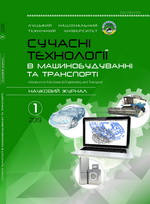Comparative evaluation of bus A11110 pneumatic suspension dismanteling alcorithms on the basis of structural analysis
Abstract
Air suspensions of buses’ steered and driving wheels consist of a big amount of parts and elements with directed connections between them. The evaluation of perfection of these connections can be performed with the help of graph theory, which take into considerations different methods for realization of ordered interrelations in the access graph. In the former the vertices denote the ends of the jobs, its edges, depicted as intercepts with arrows, describe the sequence of the disassembling jobs.
Depending of the suspension’s construction, those graphs illustrate different variants, which characterize different possibilities of access.
For mentioned purposes, among the graph’s properties the distance from the root vertice is used, which is defined as the shortest path and denoted as a whole positive number.
The greater the distance, the worse the access is. The another important property of graph is its weight, which characterize amount of assembled units and parts, connected with the root vertice, which can be detached simultaneously. The bigger the weight of root vertice is, the more perfect design of composed unit (composing part) is from the maintainability point of view, - using one disconnection several parts (composed units) can be detached, which economize on labor costs.
Evaluation of composed units or composing parts’ perfectness of automotive vehicle from point of view of the best access to the faulted part is the best performed with the help of access function, which is the main criteria of structural analysis of machine’s maintainability. Access function characterizes suitability of given machine’s design for rapid recovery from lost functionability through the change of the non-renewable fault element.
That is why in this article the design features of air suspensions of ruled and driving wheels of A11110 bus are described, their three-level access graphs are mapped and access functions for three options of disassembling works are calculated. Quantative analysis of access functions has shown that the most rational option for disassembling of bus’ suspensions is the second one. Proposed method of structural analysis of bus’s suspension maintainability can be applied for other parts of automotive vehicles.
Key words: pneumatic suspension, bus, maintainability, access, graphs and functions.




